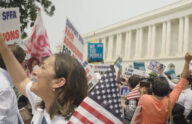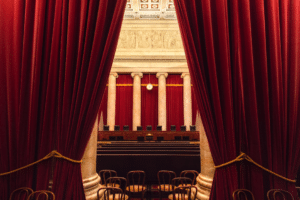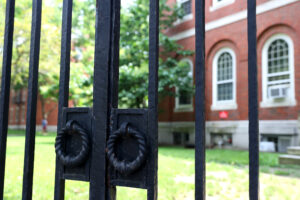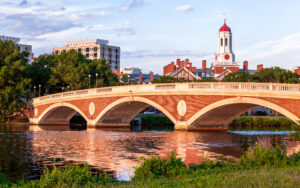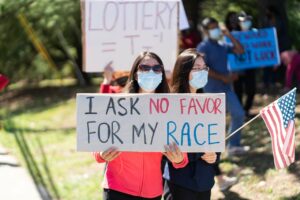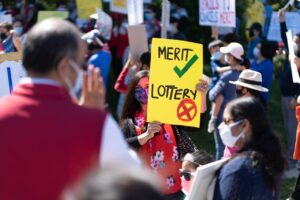Education officials spread poisonous myth that Asian students are ‘test-taking robots’

Envy: a feeling of resentful longing aroused by someone else’s possessions, qualities, or luck
“I walked into Stuyvesant High school and I thought I was in Chinatown,” Milady Baez, then-deputy chancellor of the Department of Education in New York City, complained to colleagues at a 2018 meeting. Baez’ point was clear: There were, in her opinion, far too many Asian American students at the city’s top magnet school.
Baez was penalized (although not fired) for her remark. But she was only expressing what other government officials and educators have said in so many words: that Asian Americans are unfairly overrepresented at the nation’s top schools and universities.
One New York University professor described it as “opportunity hoarding” by “privileged racial and ethnic communities.” Former Virginia Secretary of Education Atif Qarni compared Asian American families’ test prep to “performance-enhancement drugs.” Then-New York City Chancellor of Schools Richard Carranza said, “I just don’t buy into the narrative that any one ethnic group owns admission to these schools.” Alison Collins, vice president of San Francisco’s Board of Education (until she was recalled this year), tweeted that Asian Americans “use white supremacist thinking to assimilate and get ahead.”
Sometimes anti-Asian resentment boils over into unfiltered hate: California Assemblywoman Cristina Garcia was so upset by the defeat of an affirmative action proposition that she said in a closed-door meeting with colleagues: “This makes me feel like I want to punch the next Asian person I see in the face.”
The Asian stereotype
Believe it or not, there is academic research that helps explain why people like this are angered by perceived Asian American success.
A study by researchers at Princeton, Northwestern, and Lawrence universities found that people tend to stereotype groups along two axes: warmth and competence. If they stereotype a group as warm but not competent, they feel pity. If they stereotype a group as neither warm nor competent, they feel disgust. If they stereotype a group as both warm and competent, they feel admiration. If they stereotype a group as competent but not warm, they feel envy.
The researchers found that many people stereotype Asians as highly competent but cold—“test-taking robots with no personality,” as Kenny Xu, author of The Inconvenient Minority, puts it. People who stereotype Asians in this way can start seeing them as a competitive threat, and become envious.
And envy can be dangerous.
“In its most virulent form, envy is characterized by a desire to take away the coveted object or advantage from the other—even when depriving them means losing something ourselves,” Anne Hendershott writes in The Politics of Envy.
Some people are willing to lose a lot in order to deprive Asian Americans of seats they’ve earned at top schools.
They’re even willing to lose American meritocracy.
An erosion of excellence
Hung Cao was one of those students who thrived at top schools.
A Vietnamese refugee whose family emigrated to Northern Virginia after the fall of Saigon, Cao was a member of the inaugural class at Thomas Jefferson High School for Science and Technology in 1985. He later attended the U.S. Naval Academy and earned fellowships at Harvard and MIT.
At Thomas Jefferson (TJ) in Alexandria, Virginia, Cao was “a skinny Asian kid” among a “nerdy hodgepodge of teenagers,” he recalls in The Washington Post. “The unifying priority for us was that we wanted to be there, and even though we collectively groaned through those difficult four years, we thrived… Within those walls, we were iron sharpening iron and, in the end, graduated with a sense of pride that has carried us through each step of our adult lives.”
Unfortunately, the merit-based admissions process that enabled Cao to earn his seat at TJ may soon be a relic.
In 2020, the Fairfax County School Board re-engineered the TJ admissions process so that fewer Asian American students like Cao are admitted to the nation’s top magnet school. Instead of a race-blind admissions test, the new hybrid system emphasizes non-academic factors, including geographic markers that act as proxies for race. Then-Superintendent Scott Brabrand defended the change, arguing that “TJ should reflect the diversity of Fairfax County Public Schools, the community, and of Northern Virginia.”
After the new process was implemented, Asian enrollment at the school dropped from 73% to 54%.
Cao, now a retired Navy Special Operations officer and a candidate for U.S. Congress, slams the Fairfax County School Board for prioritizing the racial makeup of TJ over academic merit.
“Discriminating against one minority group to benefit another minority group has no place in our society, and it certainly has no place in our schools,” Cao says. “What I see is an activist culture replacing competition and excellence with entitlement, and it is eroding the foundation of who we are as a country.”
Although TJ parents and Pacific Legal Foundation fought the discriminatory new admissions process and won our case at district court this year, the Fourth Circuit ruled that the new process can remain in place while the school board appeals our victory.
Which means Asian American students who would have gotten into TJ on merit will now be rejected—because of their race.
This has happened before
In 1923—almost a century ago—Harvard University proudly revealed an inclusive new admissions policy that would help the student body become “properly representative of all groups in our national life.”
Instead of focusing on test scores, Harvard’s new policy would emphasize non-academic factors like personality, background, geography, and athleticism. The committee in charge called it “a policy of equal opportunity regardless of race and religion.”
But private correspondence between Harvard alumni and officials—most notably, Harvard President Abbott Lowell—reveals the true motivation behind the policy: Harvard was desperate to limit the number of Jewish students on campus.
“The summer hotel that is ruined by admitting Jews meets its fate,” President Lowell wrote to a professor, “not because the Jews it admits are of bad character […] but the result follows from the coming in large numbers of Jews of any kind, save those who mingle readily with the rest of the student body.”
Incidentally, according to the warmth/competence study on group stereotypes, many people stereotype Jewish and Asian people similarly—in a way that evokes envy.
Under the new admissions policy, Jewish enrollment at Harvard was rolled back from 21% in 1922 to 15% in 1933. For the first time, applicants were quizzed on their backgrounds and asked to send in their photos. Amorphous qualities like “character” became the new measure of an ideal Harvard man.
And if that meant the application process wasn’t quite as meritocratic as it used to be, so be it: After all, a Harvard report reasoned, “the standards ought never be too high for serious and ambitious students of average intelligence.”
A pattern of discrimination
Now Students for Fair Admissions is bringing Harvard to the Supreme Court for “engag[ing] in the same brand of invidious discrimination against Asian Americans that it formerly used to limit the number of Jewish students in its student body,” as the petitioners put it in their brief.
Looking at notes from Harvard admissions officers, it’s impossible not to see a pattern in the way Harvard treats applicants: The school consistently employs its “personality score” to downrate Asian applicants, using language that conveniently conforms to the competent-but-cold stereotype of Asians.
“He’s quiet and, of course, wants to be a doctor,” one admissions officer notes about an Asian applicant.
Another calls an applicant “so typical of other Asian applications I’ve read: extraordinarily gifted in math with the opposite extreme in English.”
The notes call to mind a particularly brutal quote from Daniel Golden’s book The Price of Admissions, in which MIT Dean of Admissions Marilee Jones says of rejected Korean American applicant Henry Park: “It’s possible that Henry Park looked like a thousand other Korean kids with the exact same profile of grades and activities and temperament… yet another textureless math grind.” Park had been rejected from multiple Ivy League schools, despite ranking and scoring higher than his peers at the private Groton School. His parents were middle-class Korean immigrants “who scrimped to send their son to Groton because of its notable college-placement record,” The Wall Street Journal reported.
After Park was rejected, his mother told the Journal that she’d been naïve. “I thought college admissions had something to do with academics,” she said.
What we lose
As PLF argues in our friend-of-the-court brief in the Harvard case, classifying Americans by crude racial categories is deeply harmful: It perpetuates false stereotypes and degrades the dignity of individuals, who each deserve to be considered on their own merits.
It also encourages the worst kind of tribalism, in which racial and ethnic groups are pitted against each other in a toxic, envy-fueled battle.
The politicians and school board members who promote a race-based “us vs. them” mentality are doing a disservice to the communities they represent. They’re especially doing a disservice to students, who are all far more dynamic and complicated than stereotypes based on the color of their skin.
In a 2007 Supreme Court case involving a Seattle school district’s use of race, Chief Justice John Roberts wrote, “The way to stop discriminating on the basis of race is to stop discriminating on the basis of race.” That’s what PLF firmly believes. The TJ and Harvard cases are about far more than the student bodies at those schools. At their core, these cases are about whether Americans are ready to stop stereotyping people by race—and start seeing each other as individuals.
This article first appeared in the fall 2022 edition of Sword&Scales.


